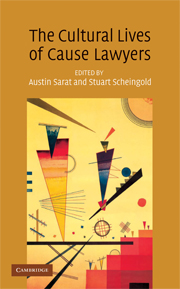Book contents
- Frontmatter
- Contents
- Acknowledgments
- Contributors
- Bringing Cultural Analysis to the Study of Cause Lawyers: An Introduction
- PART I THE CULTURAL WORK OF CAUSE LAWYERS
- PART II THE CULTURAL CONSTRUCTION OF LAWYERS AND THEIR CAUSES
- PART III THE CULTURAL RECEPTION OF LAWYERS AND THEIR CAUSES
- 11 Cause Lawyering “English Style”: Reading Rumpole of the Bailey
- 12 Now You See It, Now You Don't: Cause Lawyering, Popular Culture, and A Civil Action
- 13 Not What They Expected: Legal Services Lawyers in the Eyes of Legal Services Clients
- Index
13 - Not What They Expected: Legal Services Lawyers in the Eyes of Legal Services Clients
Published online by Cambridge University Press: 08 January 2010
- Frontmatter
- Contents
- Acknowledgments
- Contributors
- Bringing Cultural Analysis to the Study of Cause Lawyers: An Introduction
- PART I THE CULTURAL WORK OF CAUSE LAWYERS
- PART II THE CULTURAL CONSTRUCTION OF LAWYERS AND THEIR CAUSES
- PART III THE CULTURAL RECEPTION OF LAWYERS AND THEIR CAUSES
- 11 Cause Lawyering “English Style”: Reading Rumpole of the Bailey
- 12 Now You See It, Now You Don't: Cause Lawyering, Popular Culture, and A Civil Action
- 13 Not What They Expected: Legal Services Lawyers in the Eyes of Legal Services Clients
- Index
Summary
Introduction
Laypersons hold images of lawyers. These images derive from a variety of sources including prior experiences with lawyers or government bureaucracies and popular media (see Chapter 8). With the high cost of legal services, most poor people and many working and middle-class individuals have limited, if any, experience working with lawyers that might inform their images or counteract stereotypes of lawyers. Given the discrepancy between income and education levels of most lawyers and poor people in an increasingly class-stratified United States society, most are also unlikely to encounter lawyers among their friends and neighbors. So what are the images that circulate among low-income individuals who are the populations likely to be served by what Sarat and Scheingold have called “cause lawyers”? Where do these images come from? What do they tell us about the people who hold them?
This essay relies on data from interviews with thirty indigent legal services clients as part of a larger study of legal services lawyers and clients. It is a report of what Richard Johnson has referred to as “studies of lived cultures.” This means that, although one could focus on the production of texts (broadly defined to include stock myths and cultural stories) or the way in which texts circulate, this study focuses on how a group of indigent legal services clients consume, change, and produce local meanings about the lawyers with whom they work.
- Type
- Chapter
- Information
- The Cultural Lives of Cause Lawyers , pp. 359 - 388Publisher: Cambridge University PressPrint publication year: 2008

